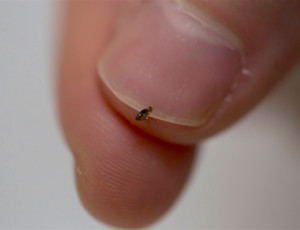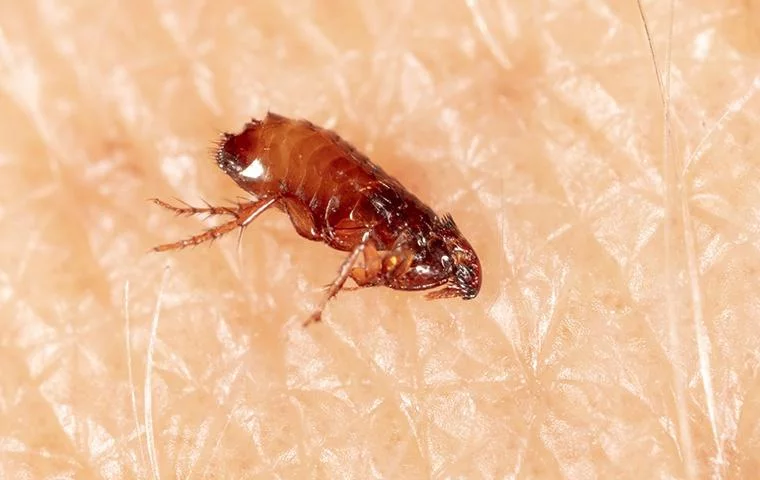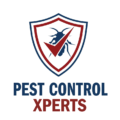Flea Treatments in Florida
Exterminator Services for Deltona, DeLand, DeBary, Orange City, Eustis, and Lake Helen
Florida’s subtropical climate – characterized by mild winters, high humidity, and generous warmth – draws people year-round seeking comfort, but it likewise fosters certain pests, especially fleas. These tiny, jumping insects feed on the blood of warm-blooded hosts – often pets, yet they also bite humans if no other host is available. Once fleas infiltrate a property, they can spread rapidly, leaving itchy bites, potential diseases, and endless occupant frustration if ignored. In Deltona, along with the surrounding locales of DeLand, DeBary, Orange City, Eustis, and Lake Helen, spotting fleas or their droppings early stops minor issues from ballooning into full-blown outbreaks. This service page clarifies how fleas thrive in Florida’s environment, the signals revealing their presence, and why a professional flea exterminator for flea treatments is often the most effective way to reclaim a pest-free living or business space. Swift occupant action upon discovering suspicious pet scratching or jumping fleas spares you from ongoing bites, occupant worries, and potential complications affecting both animals and humans.
Why Fleas Thrive in Florida

- Mild Winter Climate
In cooler states, extended sub-freezing weather helps kill or stall flea populations for months, reducing pest concerns until spring. Florida’s winter hardly dips into sustained freezing temperatures, which means fleas remain active continuously. Indoors, climate-controlled rooms offer stable warmth, guaranteeing fleas no seasonal lull if occupant or caretaker vigilance falls short. - High Humidity and Rain
Flea eggs, larvae, and pupae need moisture to develop. Florida’s frequent rainfall and humidity keep yards, gardens, or shady corners damp, enabling flea eggs to hatch and progress smoothly through each life stage. Even moderate rains maintain the moist conditions fleas require if occupant yard or housekeeping efforts don’t disrupt them. - Minimal Seasonal Downtime
In regions with harsh winters, fleas experience forced dormancy, dropping numbers significantly over cold months. In Deltona and nearby communities, no such pause in flea breeding occurs. A few neglected fleas can escalate swiftly into an infestation, forcing occupant or professional steps to intervene year-round. - Frequent Pet and Wildlife Hosts
Fleas often target dogs, cats, and local wildlife like raccoons or possums traveling yard edges. Unprotected pets missing monthly flea preventatives quickly bring fleas indoors, depositing eggs in carpets, rugs, or bedding. Occupant checks – such as grooming or vacuuming – hamper these expansions, but ignoring routine upkeep opens the door to advanced infestations. - Human Traffic and Secondhand Goods
Areas around Deltona see occupant turnover, short-term rentals, or secondhand product exchanges that inadvertently move fleas in hidden folds of fabric or personal items. Without occupant or staff checks – like vacuuming new furniture – fleas hide and feed, quietly multiplying until occupant bites or repeated pet scratching alerts them to the problem.
Signs You Might Have a Flea Infestation
- Excessive Pet Scratching or Grooming
A key indicator is a dog or cat persistently biting its fur, especially near the tail base, belly, or neck. Fleas concentrate in warm, slightly fur-sparse areas. Pets with pronounced flea allergies may show hairless patches or red, inflamed skin from intense scratching. Inspecting your pet’s coat may reveal small dark fleas or black “flea dirt” turning red when moistened. - Seeing Fleas on Floors or Furniture
Adult fleas, typically 1–3 millimeters long, can leap several inches. If occupant footsteps disturb them, you may catch a tiny black insect hopping across the carpet or near couch cushions. Spotting just a few often signifies more remain hidden in deeper layers, spurring occupant or professional intervention for thorough elimination. - Flea Dirt in Pet Bedding
Flea droppings appear as black pepper-like specks, often accumulated in places where pets rest. Testing them on a damp white cloth can produce a red tinge, confirming digested blood. This strongly suggests active fleas feeding on your animal companions. - Unexplained Bites on Humans
While fleas prefer animal hosts, they will bite people if pets are unavailable. Flea bites often show up on ankles or lower legs, forming small, itchy red bumps or welts in lines or clusters. If occupant bites recur daily, especially after time spent near carpets or pets, fleas become the top suspect. - Pets Avoiding Key Spots
A dog or cat suddenly shunning a favorite corner or cushion signals fleas saturating that area. Investigating the bedding or yard patch frequently reveals adult fleas waiting to latch onto the next passing host.

Why Prompt Flea Treatments Are Crucial
- Possible Disease and Parasite Transmission
Though not the most notorious disease carriers, fleas can transport parasites like tapeworms, occasionally infecting pets or humans. Heavy feeding from fleas can cause anemia in smaller animals or lead to allergic dermatitis. Eliminating fleas at the first indication ensures occupant comfort and animal well-being. - Continuous Biting and Irritation
Flea bites lead to persistent itching and occupant frustration. For pets, unrelenting scratching can spawn open sores or bacterial infections. By addressing fleas quickly, occupant or vet bills for extended pet treatments and occupant stress from repeated bites are minimized. - Spread to Neighbors or Adjacent Units
In multi-family dwellings or tightly spaced neighborhoods, fleas may jump across shared yards or hallways if occupant solutions remain incomplete. Early occupant checks, plus building-wide coordination, blocks fleas from migrating and establishing themselves in new areas. - Daily Occupant Stress
Living with fleas disrupts occupant routines – from the annoyance of new bites to the burden of near-constant laundering or vacuuming to quell them. Thorough eradication relieves occupant anxiety, restoring confidence in a safe, itch-free home or workplace.
Why a Professional Exterminator Is Best
- Comprehensive Indoor-Outdoor Evaluation
A flea exterminator inspects both indoor floors (carpets, pet bedding, behind furniture) and yard edges for eggs, larvae, or adult fleas. Knowing each life stage – egg, larva, pupa, adult – clarifies whether occupant must focus on yard grooming, chemical treatments indoors, or both. - Safe, Targeted Applications
Over-the-counter foggers may oversaturate occupant spaces without destroying fleas concealed in corners. Professionals strategically apply insect growth regulators or adulticides in zones where fleas typically gather, ensuring fleas meet lethal contact while occupant chemical exposure remains minimal. - Destroying Every Life Stage
Fleas pass through four phases. Missing even pupae can lead to re-emergence weeks after occupant or caretaker attempts. Exterminators integrate yard larvicides, indoor insect growth regulators, occupant vacuuming, or sometimes steam to knock out fleas at each stage comprehensively. - Pet and Veterinarian Coordination
While exterminators tackle environments, occupant synergy with vet-prescribed monthly flea meds ensures dogs or cats do not reintroduce fleas after yard outings. Medicated animals kill fleas feeding on them, blocking new eggs from being laid. - Follow-Up and Assurance
Because flea eggs can hatch days after initial occupant or professional coverage, occupant re-checks confirm no new adult fleas slip past. If occupant bites recur or fleas reappear, further yard or indoor spot treatments finalize occupant peace of mind.
Potential Methods for Flea Control
- Vacuuming and Steam Indoors
Vacuuming surfaces collects adult fleas, eggs, and pupae from carpets, rugs, or furniture. Occupants discard the contents in sealed plastic outside. Steam – lethal heat – can reach deeper layers in upholstery, ensuring no hidden pockets survive normal chemical sprays. - Insect Growth Regulators (IGRs)
IGRs impede flea larvae from maturing into biting adults. Indoors, occupant or professional usage near baseboards or corners ensures fleas never progress to the adult, blood-feeding stage. Outdoors, larvicides or yard sprays hamper egg hatching or larval survival. - Adulticidal Sprays or Granules
Fleas often lurk in shady, moist yard sections. Exterminators apply adulticides to yard perimeters or damp corners. Indoors, occupant or professional usage near baseboards kills fleas crossing the treated areas. Occupants usually keep pets out until dryness for maximum safety. - Pet Defense
Occupants consult veterinarians on monthly flea preventatives. A single unprotected animal can swiftly re-introduce fleas from outside or hamper occupant-based environmental treatments. By medicating dogs or cats, fleas feeding on them soon die, crippling reproduction cycles. - Monitoring
Because newly hatched fleas can appear weeks after occupant or caretaker elimination attempts, occupant re-checks or sticky traps confirm no leftover fleas remain. If occupant bites or sightings persist, additional treatments in yard corners or behind furniture finalize occupant relief.

Serving Deltona, DeLand, DeBary, Orange City, Eustis, and Lake Helen
Deltona: Growing neighborhoods may inadvertently attract fleas if occupant or caretaker efforts skip thorough yard cleaning or consistent pet medication. Regular occupant checks—like scanning dogs after park visits—plus swift extermination solutions keep fleas from dominating carpets or bedding.
DeLand: With historic homes and new developments, DeLand sometimes sees occupant turnover, potentially bringing fleas via secondhand furniture. Occupants verifying used items for fleas or vacuuming thoroughly hamper expansions, while professional oversight crushes hidden egg clusters behind couch seams.
DeBary: Suburban with older farmland edges, DeBary might host wildlife crossing lawns. If occupant yard maintenance or dryness measures remain limited, fleas deposit eggs in shady corners. Quick occupant synergy—like frequent vacuuming—and specialized solutions eliminate fleas before they permeate multiple rooms.
Orange City: A smaller community experiencing occupant changes, which can unknowingly transport fleas in personal items or crates. Occupant diligence—like routine scanning of pet bedding—plus professional insect growth regulators hamper fleas from saturating entire floors or furniture sets.
Eustis: Scenic lake areas near Eustis can foster wildlife that drop fleas along yard edges. Occupants with unprotected pets or unmaintained yards might see fleas slip indoors. Coordinating occupant housekeeping with a robust extermination plan ensures fleas cannot colonize bedrooms or living spaces.
Lake Helen: Known for its calm environment, Lake Helen’s mild climate fosters fleas indoors if occupant or caretaker vigilance is absent. Observing repeated bites or noticing black “flea dirt” on pet blankets demands immediate occupant or professional steps to derail further expansions.
Why Our Flea Treatments Excel
- Florida-Focused Approach
Because southwestern Florida rarely sees freezing temperatures that reduce flea cycles, occupant synergy—like dryness management, yard grooming, monthly pet preventatives—plus targeted yard larvicides or adulticides effectively corners fleas at each life stage, from egg to adult. - Precision, Minimal Occupant Disruption
We place insect growth regulators, adulticidal sprays, or yard granules exactly where fleas lurk—behind pet bedding, in carpet seams, or moist yard edges—limiting occupant or pet chemical exposure. Occupants typically wait until dryness or recommended intervals before resuming normal usage of treated spots. - Pet Synergy
Since fleas feed on animals, occupant synergy with vet-approved monthly topicals or oral treatments kills fleas on dogs or cats, halting re-infestation. Without medicated pets, new fleas from outdoors easily reinvade carpets or furniture. - Follow-Up Assurance
Because eggs or pupae may hatch weeks later, occupant checks confirm if any fresh adult fleas appear. If occupant sightings persist—like fresh bites or live fleas jumping near floors—additional spot treatments finalize occupant peace, ensuring no hidden flea caches survive behind furniture or yard corners.
Next Steps
Have you observed persistent pet scratching, found tiny insects jumping on carpet, or discovered itchy red bites around ankles after walking indoors? Contact us to learn more or schedule your service. Our flea exterminator solutions in Deltona, DeLand, DeBary, Orange City, Eustis, and Lake Helen annihilate fleas from egg to adult, indoors and out, ensuring occupant relief and safeguarding pets. Prompt occupant action – rather than ignoring minor sightings or relying on partial do-it-yourself efforts – spares you from repeated bites, occupant frustrations, and potential disease concerns these parasites occasionally harbor.
By merging occupant housekeeping—like thorough vacuuming, washing pet bedding on hot cycles, or discarding damp yard litter—with specialized approaches—like insect growth regulators, adulticides, or yard granules—fleas encounter lethal contact at each phase of their life cycle. Freed from the unending itch of hidden parasites, southwestern Florida homes or businesses can resume daily life, confident that no concealed fleas lie waiting in corners or yard edges.
